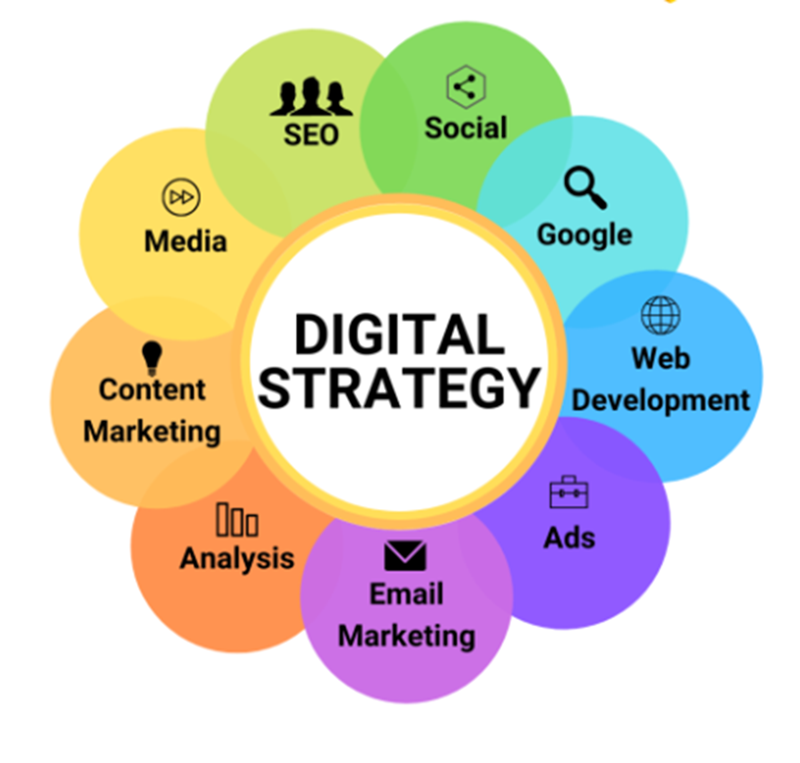
Strategy Page: How To Develop A Winning Digital Strategy
Welcome to our complete guide on crafting a winning digital strategy! In our digital world, it’s crucial for businesses to build a strong online presence. A well-designed strategy page acts as a roadmap, showing how to boost your online presence and website traffic.
Creating an effective digital strategy is more than just mixed marketing actions. It needs careful planning and steps to get real results. By making a solid digital strategy, companies can find their audience, raise brand visibility, and increase sales. Follow our guide for useful insights and actionable steps to create a top marketing strategy.
We will talk about setting goals, knowing who you are targeting, creating interesting digital content, and choosing the best marketing paths. We’ll also talk about how vital data analytics are, keeping up with marketing trends, and making your strategy as good as it can be.
No matter if you’re starting out or have been around, this guide has what you need to make a successful digital strategy. Let’s start and explore how to grow your online business!

Understanding the Role of a Strategy Page in Digital Strategy Development
A strategy page is key in managing digital initiatives. Think of it as the core that links all parts of a digital strategy together. This ensures a smooth and united approach. Understanding its role helps businesses plan and carry out their digital strategies well. This leads to better outcomes and success over time.
It acts like a guide for businesses to set their aims and plans. This roadmap aids in making choices, letting businesses use their resources well and boost their efforts. It’s a point of reference for all involved, making sure they are moving towards the same goal.
A strategy page also connects the digital plan with the business’s overall aims. This helps link digital moves to bigger company goals, promoting unity. Such alignment improves teamwork across different areas, enhancing coordination and cooperation.
A well-developed strategy page gives a full view of a business’s digital strategy. This supports smart decision-making and proper use of resources.
Moreover, a strategy page allows businesses to keep an eye on their digital plan’s performance. It sets up KPIs and uses tools to track how well different digital actions are doing. Using data helps businesses see what needs work and adjust their plans for better digital performance.
Also, a strategy page is a great way to communicate, both inside and outside the company. It shares the digital strategy with those involved, like bosses, workers, and partners. This builds a common understanding. A good strategy page also boosts the brand’s image and draws in customers by showing a clear digital presence.
To visualize the role of a strategy page in digital strategy development, refer to the image below:
The Importance of Clearly Defined Digital Strategy Objectives
It’s vital for businesses to set clear digital strategy objectives. Without them, measuring success and making decisions can be difficult. These objectives guide companies in planning and executing online actions. We’ll look at why setting goals is key to success.
Setting SMART Digital Goals
SMART goals help define digital strategy objectives. They are specific, measurable, achievable, relevant, and time-bound. This method helps businesses set clear and realistic targets. And it ensures these targets support the overall strategy.
Instead of a vague aim like “get more website visitors,” use a SMART goal. For example, aim to “boost website traffic by 20% in six months with SEO and content marketing.” This goal sets a clear target, ways to measure it, steps to achieve it, aligns with larger plans, and has a deadline.
Mapping Objectives to Business Goals
Digital strategy objectives must align with the business’s broader goals. It’s crucial for digital plans to aid in growth, revenue, customer acquisition, or brand awareness. Aligning digital and business goals ensures digital efforts support overall success.
For instance, to grow in a specific market, a digital goal could be increasing online engagement with that audience. This approach integrates digital strategies with the company’s aims. It helps use digital channels to meet larger business objectives.
The image shows how essential clear digital strategy objectives are for companies. Setting SMART goals and aligning them with business aims drives growth and improves performance. It helps achieve goals in the digital realm.
Identifying and Analyzing Your Target Audience
To build a winning digital strategy, start by knowing your target audience well. It’s important to understand what your audience enjoys, needs, and struggles with. Doing so makes it easier to create digital strategies that really speak to them. A good look at who they are helps your marketing work better.
Think about who your audience is and what they need. Look at their age, what they do, what drives them, and what they like. This helps you figure out how to please them with your content and what you offer.
Breaking your audience into groups is crucial. You group them by their common traits, like how old they are, their gender, where they live, what they’re into, or how they spend their money. This way, you can talk to each group in a way that hits home. It makes your digital plans work harder.
Getting your digital strategy right means really connecting with your target audience. Putting in the effort to understand and divide your audience means you can create digital plans that truly make an impact.
Conducting Thorough Competitive Analysis in the Digital Space
To shape a strong digital strategy, carrying out a detailed competitive analysis is key. This step allows businesses to deeply understand the online battlefield. They see where they can fill gaps and spot chances for growth.
Understanding Competitor Digital Footprints
Competitor digital footprints show how rival companies appear and act online. They cover their websites, social media, how high they rank in searches, how they market content, and their ads online. Looking into these areas gives insight into what competitors do well and where they fall short.
By checking out competitor websites, companies can learn what works in terms of design and content. This knowledge helps them upgrade their own sites. They can stand out by offering users something better and more captivating.
“Analyzing competitor digital footprints helps businesses identify areas for improvement and innovation, enabling them to differentiate themselves and provide a more compelling digital experience.”
Also, diving into competitors’ social media can uncover their audience types and what content they like. This insight directs companies in shaping their own social media efforts. They can discover unmet needs in the market to address.
Current Market Trends and How to Leverage Them
For a competitive edge, businesses must know and use current market trends. Keeping an eye on these trends helps them tweak their digital strategies to match what users like and want.
Now, users crave personalized digital experiences that feel made just for them. Companies can meet this demand by tailoring content and deals for different audience segments. This approach makes customer interactions more relevant and impactful, boosting satisfaction and loyalty.
Mobile devices are also changing the game for online marketing. As mobile use climbs, ensuring websites work well on mobile isn’t optional—it’s a must. Companies need to ensure their digital presence shines on all screens. This way, they reach their audience no matter the device, improving their digital strategy’s effectiveness.

Creating Resonant Digital Content and Messaging
In today’s world, making strong digital content is vital for businesses to reach their audience well. By using a solid content strategy and good brand storytelling, companies can build a robust online presence. This lets them share what they offer in a clear way.
The saying “Content is king” holds a lot of weight in digital marketing. Good digital content can engage and inspire people, leading them to take action. This could be through a blog, a video, or social media posts. Making content that grabs attention is essential for reaching potential customers.
A strong content strategy makes sure all digital content aligns with the business’s main goals. This includes identifying who the audience is, researching their needs, and making content that speaks to them. When your message hits the mark, you build a strong connection. This leads to brand loyalty and support.
Also, telling a great brand story is key in forming how people see your business. Sharing your mission, values, and what makes you unique helps set you apart from others. It builds a deeper connection with your audience.
Adding visual elements like infographics and videos can make your content more engaging and shareable. Visuals are easier to digest and can help spread the word about your brand. They’re a powerful way to boost your brand’s awareness.
To wrap up, making meaningful digital content and messages is critical for any business that wants to stand out online. With a well-thought-out content strategy, businesses can grab their audience’s attention, build a solid online presence, and clearly communicate their brand’s value.
Choosing the Right Mix of Digital Marketing Channels
In today’s digital world, businesses have many digital marketing channels to choose from. Finding the best channels for your goals can be hard. This section offers insights on picking the right digital marketing mix.
Maximizing Social Media Efficacy
Social media is key to digital marketing success. Facebook, Instagram, Twitter, and LinkedIn help businesses connect with their audience. First, find where your audience hangs out the most.
Research and look at data to pick the best channels for your market. Focus on these platforms to boost engagement. Adjust your content for each platform, use hashtags, influencers, and ads to reach more people.
Optimizing for Search Engine Visibility
Being seen on search engines like Google is vital. Most people use search engines to look for products and services. Make your website and content search-friendly to pull in more visitors.
Do keyword research to find what your audience looks for. Use these keywords in your website and content. Also, make content that’s useful to your audience. By doing this, you improve your spot in search results, which helps reach more customers.
Strategizing Email Marketing for Better Engagement
Email marketing is great for connecting with your audience. Create a smart email strategy to send messages that talk directly to your subscribers. Begin by gathering an email list of interested people and current customers.
Divide your list to target your emails better. Write engaging emails that offer value, like tips, deals, or recommendations. Use automation tools to send emails at the right time. Keep track of your emails’ success to make your strategy even better.

Choosing the best digital marketing channels is crucial for your strategy’s success. Use social media, search engine optimization, and email marketing wisely. These methods will help you engage your audience better and boost your digital success.
For more tips on a digital marketing strategy for big brands, read this article on Forbes.
Strategy Page: Crafting Seamless Digital User Experiences
In today’s world, a strategy page is crucial for smooth digital user experiences. It acts as a central place for businesses to improve their websites. This ensures users find it easy to navigate and engage with the site.
Optimization of the website is vital for standout user experiences. Focusing on design that puts users first helps businesses. This boosts usability and function. Happy customers and more user activity lead to better business results.
Website optimization is not just about aesthetics; it’s about providing a smooth and enjoyable user journey that aligns with the goals of your digital strategy.
To optimize a strategy page, focus on easy navigation, clear calls-to-action, and a design that works on all devices. These steps make your page more accessible and enjoyable, regardless of how users visit it.
It’s also important to make pages load quickly through website optimization. Fast pages not only please users but also help with search engine rankings. This increases traffic to your site.
Creating smooth digital user experiences on your strategy page is key. It leads to happier customers and more engagement, helping you to meet your online goals. For more insights on how web design and marketing impact your online presence, read Crafting a Digital Presence: The Impact of Web Design and Marketing.
Building a Comprehensive Link Building and SEO Strategy
This section will explore key strategies for link building and SEO. These methods improve site traffic and boost search rankings. Mastering link building and SEO is vital for better online visibility. They help attract more visitors naturally.

Keyword Research for Effective SEO Optimization
Optimizing your site for search engines starts with keyword research. This process identifies what your audience searches for online. Using these keywords across your site makes it easier for people to find you in search results.
According to Search Engine Journal’s link building guide, proper keyword research helps align your website content with the needs and preferences of your target audience, resulting in higher search engine rankings and increased website traffic.
It’s crucial to pick keywords wisely, focusing on their search volume, competition, and relevance. Use keyword tools and data analyses. This helps find and apply high-performing keywords suitably in your content.
Advanced Link Building Tactics to Boost Website Traffic
Link building strengthens your website’s authority and trustworthiness. Getting links from trusted sources can lift your rank in search results. It also brings more specific visitors to your site.
For a better link building strategy, consider these methods:
- Create valuable content that others want to link to.
- Guest blog on well-known sites to gain backlinks and show your expertise.
- Talk to influencers and experts in your field for content collaborations or to get backlinks.
- Join industry forums and communities to share your knowledge and find link partners.
The Search Engine Journal’s link building guide provides comprehensive insights and techniques for implementing a successful link building strategy, driving quality traffic to your website.
Using these advanced tactics and keeping an eye on your link profile will improve your site’s traffic and visibility in search results.
Utilizing Data Analytics to Refine Your Digital Strategy
Data analytics is key in boosting your digital strategy and results. It helps businesses fine-tune their approach and make smart choices to hit their targets. You can use data analytics tools to track and measure important metrics. This gives insights into how well your digital marketing is doing.
It’s vital to keep track of your strategy’s performance. This lets you see how successful your efforts are and find areas to get better. Looking at the data helps reveal trends, behaviors, and patterns. With this info, you can tweak your strategies to be more effective.
“Data analytics provides actionable insights that allow businesses to understand their audience better and tailor their digital strategies to meet their needs.”
For instance, analyzing website traffic sheds light on user actions. By studying how visitors interact with your site, you gain valuable insights. This can pinpoint where your site or content might need improvement to boost engagement and conversions.
Personalizing your marketing is another advantage of data analytics. By understanding your audience’s preferences, you can offer content and deals that appeal more to them. This can lead to better engagement and more sales.
Analyzing data also helps measure your marketing campaigns’ success. By looking at metrics like click-throughs and conversions, you can see what’s working. Then you can adjust your campaigns as needed to be more successful.
Data analytics offers a treasure trove of info to guide your strategy. Using this data can sharpen your marketing, making your campaigns better and improving results over time.
Next, we’ll explore how staying updated with digital marketing trends and adapting to new practices can keep you ahead of your competitors.
Keeping Up with the Dynamics of Digital Marketing Trends
Today’s digital world changes quickly. To stay competitive, it’s key for companies to be ahead. Understanding and using new digital marketing trends is vital. It lets businesses use fresh practices and technologies for better growth.
Adapting to Emerging Online Marketing Practices
Adapting to new online marketing ways is important in keeping up. As what customers like shifts, companies must keep up with what works. This means knowing the latest in social media, content ways, and how to connect with customers.
For tips on staying current, check out WebFX’s blog post on how to keep up with marketing trends. It’s full of insights and advice for navigating changes and putting good practices in place.
Leveraging New Technologies for Digital Advancements
Using new tech is crucial in digital marketing trends. Technology keeps advancing. Companies need these new tools to boost their online efforts. Think of how artificial intelligence, virtual reality, and voice search can change the game.
By adding these techs into their plans, companies can make unique and engaging experiences. This can improve how they connect with people and stand out. Keeping an eye on tech progress and how to use it is key for staying on top.
“The digital marketing world always changes. Companies must be ready to change too. By following digital marketing trends closely, they can be one step ahead. This can take their digital efforts further.”
Conclusion
Having a strong digital strategy is crucial for businesses aiming for success. This article has shown key elements and strategies. By applying these tips, companies can boost their online profile. They can also connect better with their customers and see real benefits.
A strategy page is central to organizing digital efforts. It helps set clear goals that match the company’s aims. Through audience analysis and competitive research, firms can focus their digital efforts. They can meet their audience’s needs while staying competitive.
Good digital content and choosing the best marketing channels are critical. They grab and keep your target audience’s attention. Focusing on user experience and using data analytics improves strategies. Staying up-to-date with marketing trends and new tech is also key.
We hope this article inspires companies to build their digital strategy. Using the advice given can lead to growth and success. For more on creating a winning digital strategy, visit the digital strategy conclusion page on our site.














